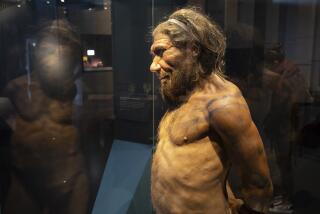A theory of world history based on our desire to network
The much-touted World Wide Web of cyberspace is not the first web to link people all over the world, certainly not in the eyes of father-and-son historians William and J.R. McNeill. Indeed, the first web may have been language itself, enabling human beings to assign names to objects, construct a world of agreed-upon meanings and thus communicate with greater precision than before.
In their wide-ranging, knowledgeable book, “The Human Web: A Bird’s-Eye View of World History,” the McNeills invite us to look at human history from the first tentative steps of our “apelike ancestors” onto the African savanna some 4 million years ago to the complex global web of communication, commerce and conflict that we inhabit today. Agriculture, religion, trade and conquest are just a few of the many web-building forces that the McNeills examine.
The senior member of this authorial team, William H. McNeill, is emeritus professor of history at the University of Chicago and author of such works as “The Rise of the West” and “Plagues and Peoples.” His son, J.R. McNeill, author of “Something New Under the Sun,” is an environmental historian at the School of Foreign Service at Georgetown University. Their joint venture gamely attempts to provide an overview of the whole of human history in a mere 350 pages. Environmental history, social history, military history, economic history, the histories of technology, religion, disease, transportation and communication all come into the mix.
But although the subject is complicated, the book’s thesis is relatively simple. The authors maintain (and it’s hard to deny) that there is an overriding tendency in human history to form ever larger and more complex structures of interconnectedness. Despite occasional setbacks, these large, complex structures tend to prevail over smaller, more isolated ones because they foster greater wealth and innovation.
Eschewing metaphysical or religious speculation, the authors focus on the pragmatic and tangible manifestations of the process. Their down-to-earth approach makes for a useful, informative and in many ways irresistibly readable work of popular history, replete with colorful material about everything from the conquests of Genghis Khan to the more menacing problem of global warming.
How did a species that got its start in Africa manage to adapt to such an amazing variety of climates and terrains? Why would free-roaming bands of hunter-gatherers opt to settle down and labor in fields to grow millet, sorghum, wheat or rice? To questions such as these, the McNeills provide plausible answers: The invention of tools, the taming of fire and the development of language aided adaptation in the first case, and the ability to generate far more food proved irresistible in the second.
The authors discuss everything from animism, polytheism and the spread of Christianity, Islam and Buddhism to irrigation, epidemics, nomadic steppe tribes and the exchange of plant species between Old World and New, as American potatoes took root in Europe and European wheat flourished in America. But in addition to offering a wealth of material, this book provides a strong sense of perspective, enabling the reader to grasp something of the big picture in contemplating the infinitely complicated story of human history.
The big picture is not always a pretty one. This bird’s-eye view of history does not take note of men like Shakespeare, Goethe or Beethoven, while Michelangelo and Leonardo are mentioned only as designers of military fortifications. For history, as seen here, is a story not only of ever-expanding webs of communication, commerce and civil institutions but also of ever more lethal military technology.
Indeed, as the authors repeatedly point out, these two forms of “progress” are often linked. Human history, they contend, is a product of our ability to cooperate but also of our penchant for competition, including the ultimate form of hostile competition that is war. “Power of course comes from moral authority, charisma, wealth, and other sources,” the McNeills observe. “But often, in the end, it comes down to force and the threat of force.”
Sometimes, it may seem to the reader that the authors simply take it for granted that greater social inequality is a natural consequence of progress. This seems to have been the case in prehistoric times, when the small bands of hunter-gatherers were far more egalitarian than cultures in which peasants labored under the control of priests and emperors. But the McNeills also show us counter-tendencies, such as the development of the polis in ancient Greece. As cities, trade and population grew and the gap between rich and poor widened, the authors tell us, the “polarity between a governing elite ... and poverty-stricken tax and rent payers seemed about to emerge. But instead the Greeks invented a new master institution for themselves -- the polis -- by combining old ideas about justice with new ways of defending themselves from outside attack.” Elected magistrates replaced priests and emperors. Citizens (adult males only) participated in their government.
“Transformed into a collective hero, the polis, at least in Sparta and Athens, attracted overriding loyalties among the citizens. Kin groups, religious groups, economic activities -- all were subordinated to it.” Similarly, a major factor in the rise of urban self-government in Renaissance Europe was the weakness of family ties compared, say, with Muslim and Chinese societies, in which most enterprises were managed by families, making “it difficult or impossible to trust outsiders.” What made it easier for Europeans to trust fellow citizens and not family members? The McNeills come up with an explanation rather more recherche than the Greek polis: The widespread use of heavier plows in northwestern Europe led to cooperative effort among families: “[P]eople in those parts of Europe where cooperative moldboard plowing once prevailed still obey rules, form queues, and in general trust one another more than do the inhabitants of lands where separate families cultivated their fields independently and often distrusted their neighbors....”
This, certainly, ought to set some readers who value one current buzzword -- “civil society” -- to thinking about the limitations of another -- “family values.” For if the family or tribe is a building block of society, the inability to see beyond its boundaries has often been an impediment to joining in the larger human web. Agree or disagree with its premises, this book certainly provides food for thought.
More to Read
Sign up for our Book Club newsletter
Get the latest news, events and more from the Los Angeles Times Book Club, and help us get L.A. reading and talking.
You may occasionally receive promotional content from the Los Angeles Times.









